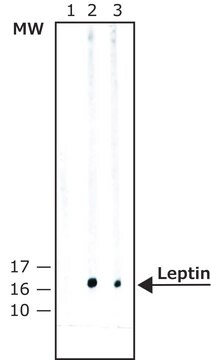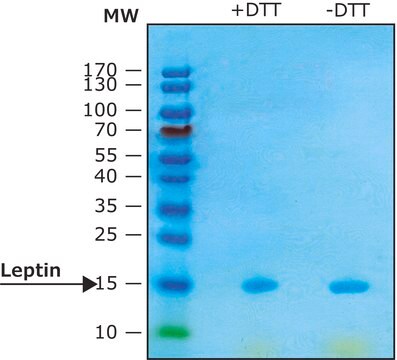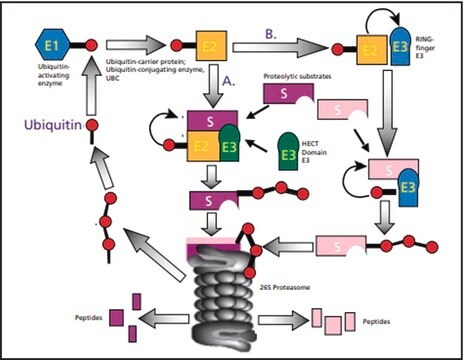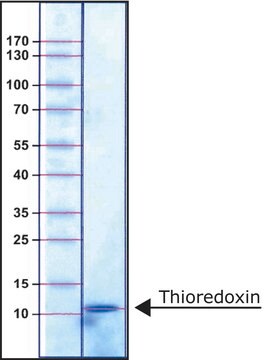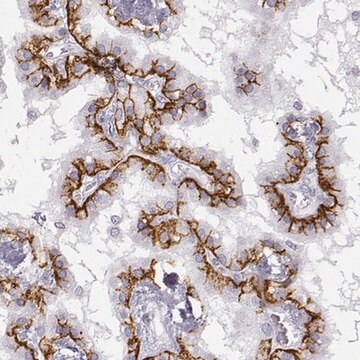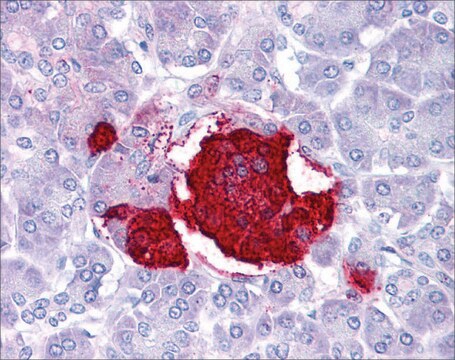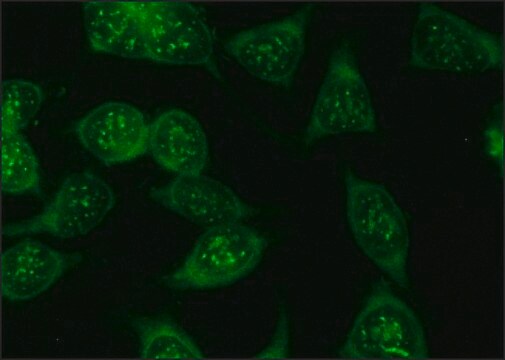추천 제품
생물학적 소스
rabbit
Quality Level
결합
unconjugated
항체 형태
affinity isolated antibody
항체 생산 유형
primary antibodies
클론
polyclonal
양식
buffered aqueous solution
종 반응성
mouse, human
기술
indirect ELISA: 1:1,000 using human or mouse recombinant leptin
microarray: suitable
western blot: 1:5,000 using human recombinant leptin
UniProt 수납 번호
배송 상태
dry ice
저장 온도
−20°C
타겟 번역 후 변형
unmodified
유전자 정보
human ... LEP(3952)
mouse ... Lep(16846)
일반 설명
The gene for leptin (LEP) is mapped to the human chromosome 7q32.1. The encoded protein is a non-glycosylated polypeptide, primarily produced and secreted by the mature adipocytes. Leptin is expressed in white adipose tissue, fetal tissues, skeletal muscle, chondrocytes, gastric chief cells, the placenta, ovary, and many immune cells. It is absent or expressed at extremely low levels in other adult tissues. Human leptin is 85% identical to mouse leptin and 84% identical to rat leptin, while mouse and rat exhibit 96% identity in their leptin molecules.
특이성
Anti-Leptin reacts specifically with leptin.
면역원
synthetic peptide corresponds to the amino terminal (amino acid residues 22-40) of human/mouse leptin.
애플리케이션
Anti-Leptin antibody produced in rabbit has been used in:
- western blotting
- immunohistochemistry
- immunocytochemistry
- enzyme linked immunosorbent assay (ELISA)
생화학적/생리학적 작용
Leptin is a circulating cytokine that induces pleiotropic effects on nutrient intake, thermogenesis, metabolism, reproduction and hematopoiesis. Leptin is hypothesized to be a “satiety factor” because the absence of this factor is associated with hyperphagia and obesity in ob/ob mice (homozygous for the obese spontaneous mutation). It appears that leptin is involved in appetite regulation since leptin injection into ob/ob mice reduces their food intake and ultimately their body weight. However, studies have demonstrated that its effects must be more complicated than simple appetite suppression.
Leptin is a hormone secreted by adipocytes and regulates energy homeostasis, inflammation and neuroendocrine processes, synaptic formation and memory condensation. The physiological effects of leptin are mediated by leptin receptors, ObR and LepR. Leptin is the key regulator of obesity and acts directly on neuronal networks to regulate feeding, metabolism and gastric mobility. The pathways that mediate the effect of leptin are Janus kinase (JAK)/signal transducer and activator of transcription (STAT), phosphoinositide 3-kinase (PI3K) and c-Jun N-terminal kinase (JNK).
물리적 형태
Solution in phosphate buffered saline containing 1% bovine serum albumin and 15 mM sodium azide.
제조 메모
The antibody is affinity isolated on peptide-agarose.
저장 및 안정성
For continuous use, store at 2-8 °C for up to one month. For extended storage freeze in working aliquots. Repeated freezing and thawing is not recommended. Storage in "frost-free" freezers is not recommended. If slight turbidity occurs upon prolonged storage, clarify the solution by centrifugation before use.
면책조항
Unless otherwise stated in our catalog or other company documentation accompanying the product(s), our products are intended for research use only and are not to be used for any other purpose, which includes but is not limited to, unauthorized commercial uses, in vitro diagnostic uses, ex vivo or in vivo therapeutic uses or any type of consumption or application to humans or animals.
적합한 제품을 찾을 수 없으신가요?
당사의 제품 선택기 도구.을(를) 시도해 보세요.
Storage Class Code
10 - Combustible liquids
WGK
WGK 3
Flash Point (°F)
Not applicable
Flash Point (°C)
Not applicable
이미 열람한 고객
Mónica Z Jenks et al.
Scientific reports, 7(1), 8232-8232 (2017-08-16)
Leptin is an adipokine produced by fat cells that regulates food consumption and metabolic activity. Sexual dimorphism in leptin and fat stores have been observed in humans and rodents with females having more leptin and greater levels of subcutaneous fat
Angela Katherine Odle et al.
Endocrinology, 157(4), 1443-1456 (2016-02-10)
Leptin regulates food intake and energy expenditure (EE) and is produced in adipocytes, the pituitary, and several other tissues. Animals that are leptin or leptin receptor deficient have major metabolic complications, including obesity. This study tests the hypothesis that the
Sandra Barbosa-da-Silva et al.
PloS one, 7(7), e39837-e39837 (2012-08-01)
Obesity is associated with low-grade chronic inflammation attributed to dysregulated production, release of cytokines and adipokines and to dysregulated glucose-insulin homeostasis and dyslipidemia. Nutritional interventions such as dieting are often accompanied by repeated bouts of weight loss and regain, a
Kate Sullivan et al.
Human molecular genetics, 23(5), 1250-1259 (2013-10-29)
There is emerging evidence for reduced muscle function in children with neurofibromatosis type 1 (NF1). We have examined three murine models featuring NF1 deficiency in muscle to study the effect on muscle function as well as any underlying pathophysiology. The
Weihong Pan et al.
Annals of the New York Academy of Sciences, 1264, 64-71 (2012-04-26)
Leptin, an adipocyte-derived cytokine, crosses the blood-brain barrier to act on many regions of the central nervous system (CNS). It participates in the regulation of energy balance, inflammatory processes, immune regulation, synaptic formation, memory condensation, and neurotrophic activities. This review
자사의 과학자팀은 생명 과학, 재료 과학, 화학 합성, 크로마토그래피, 분석 및 기타 많은 영역을 포함한 모든 과학 분야에 경험이 있습니다..
고객지원팀으로 연락바랍니다.